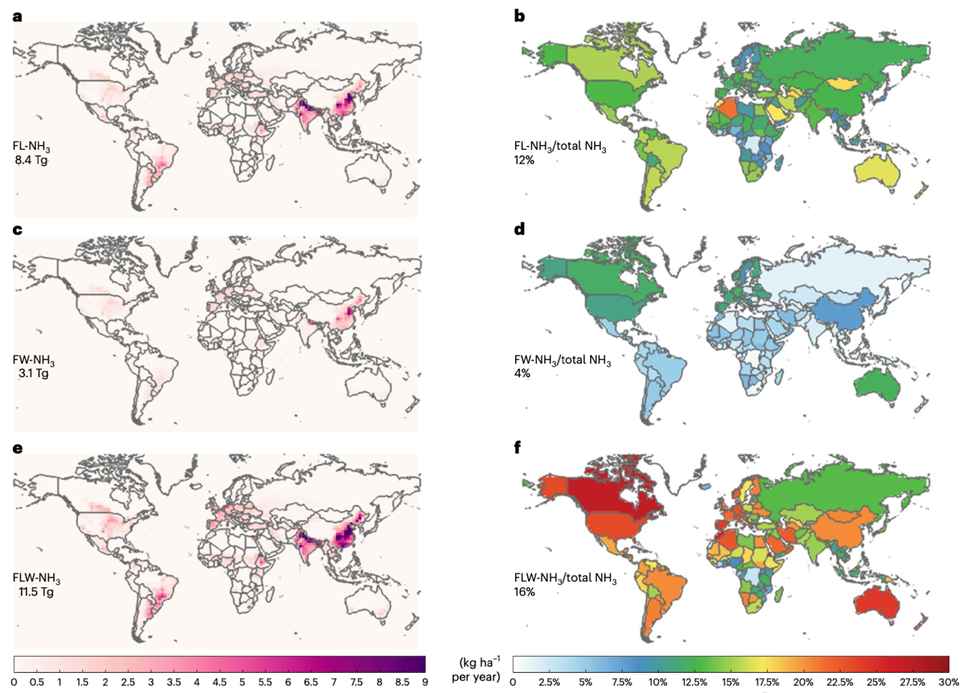大气活性氮环境效应的研究进展
张霖
张霖课题组近几年关注大气活性氮(氨、氮氧化物等)排放及其大气环境效应。2023年度课题组在研究活性氮最优减排路径和全球食物损失浪费与大气环境关联机制方面取得了重要研究进展。
课题组联合国际研究团队,集成WRF-Chem区域空气质量模式,最新的欧洲人为排放清单估计、人体健康暴露模型和活性氮排放控制成本数据,系统地分析了不同程度的Nr(NH3和NOx)排放控制对欧洲PM2.5空气质量的影响。研究发现,在东欧低水平的NH3或NOx减排有类似的PM2.5浓度缓解效果。然而,在西欧地区减排水平超过40%时,NH3减排才开始有效。随着欧洲排放控制水平的提高,NH3减排效率增加,而NOx减排效率则略有下降。研究团队结合PM2.5污染缓解有效性和实施成本,设计了具有成本效益的欧洲Nr排放控制的最优路径。相关研究成果发表于《自然·通讯》。
从农作物消耗角度,联结我国的“光盘行动计划”到联合国可持续发展目标第12.3条“2030年全球减半食物损失和浪费”, 课题组融合多学科研究方法,评估了在当前或未来减少全球食物损失与浪费(FLW)对NH3减排、PM2.5污染减缓、氮沉降减缓的效益。研究发现,在2015年FLW贡献了11.4 百万吨NH3排放,占人为源排放16%。其中,食物损失相关NH3排放占人为排放12%,食物浪费占4%(图1)。避免FLW可使全球氮沉降减少7%,全球生物多样性热点区域的氮沉降超标率将减少19%。减少全球食物损失浪费背后的农业NH3排放,尽管相比于全球农业生产技术改进带来的农业NH3减排潜力(41%)要小,但对促进活性氮污染治理仍有着不可忽视的作用。相关研究成果发表在《自然·食物》。
Research Progress on environmental effects of reactive nitrogen
Prof. Zhang, Lin’s group has recently focused on the emissions of atmospheric reactive nitrogen (such as ammonia, nitrogen oxides, etc.) and their environmental effects. In 2023, the research group made significant progress in studying the optimal reduction pathways for reactive nitrogen emissions and the linkage between global food loss and waste to atmospheric environment.
Zhang’s group collaborated with an international team to integrate the WRF-Chem regional air quality model, the latest emissions estimates for Europe, human health exposure models, and data on the cost of controlling reactive nitrogen emissions. We systematically analyzed the impact of different levels of Nr (NH3 and NOx) emission controls on PM2.5 air quality in Europe. We found that in Eastern Europe, reducing NH3 or NOx emissions at low levels has similar effects in mitigating PM2.5 concentrations. However, in Western Europe, NH3 reduction becomes effective only when emission reductions exceed 40%. The efficiency for NH3 controls increases at high-ambition reductions while NOx slightly decreases. Combining the effectiveness of PM2.5 pollution mitigation and implementation costs, we designed a cost-effective optimal pathway for controlling European Nr emissions. This work was published in Nature Communications.
From the perspective of agricultural consumption, linking China's "Clean Plate Action" to United Nations Sustainable Development Goal 12.3 to halve global food loss and waste by 2030, we employed interdisciplinary research methods to assess present and future benefits of reducing global food loss and waste (FLW) on NH3 emission reduction, PM2.5 pollution mitigation, and nitrogen deposition mitigation. We found that in 2015, FLW contributed to 11.4 million tons of NH3 emissions, accounting for 16% of anthropogenic emissions. Among these, food loss-related NH3 emissions accounted for 12% of anthropogenic emissions, while food waste accounted for 4% (Figure 1). Avoiding FLW would lead to a 7% reduction in global nitrogen deposition, and the rate of excessive nitrogen deposition in global biodiversity hotspots would decrease by 19%. Although the reduction in agricultural NH3 emissions associated with global food loss and waste is smaller than the mitigation potential from global agricultural technology improvements (41%), it still plays a significant role in promoting the control of reactive nitrogen pollution. The related findings were published in Nature Food.

Figure Contribution of global FL and FW to NH3 emissions in 2015. Panels a, c, and e are in absolute terms (kg NH3 ha−1 per year), and b, d, and f are shares in total anthropogenic NH3 emissions (%).
图 2015年全球食物损失(FL)与食物浪费(FW)对氨排放的贡献。a、c和e为氨排放量(kg NH3/ha/年);b、d和f为在总人为源的百分占比(%)
